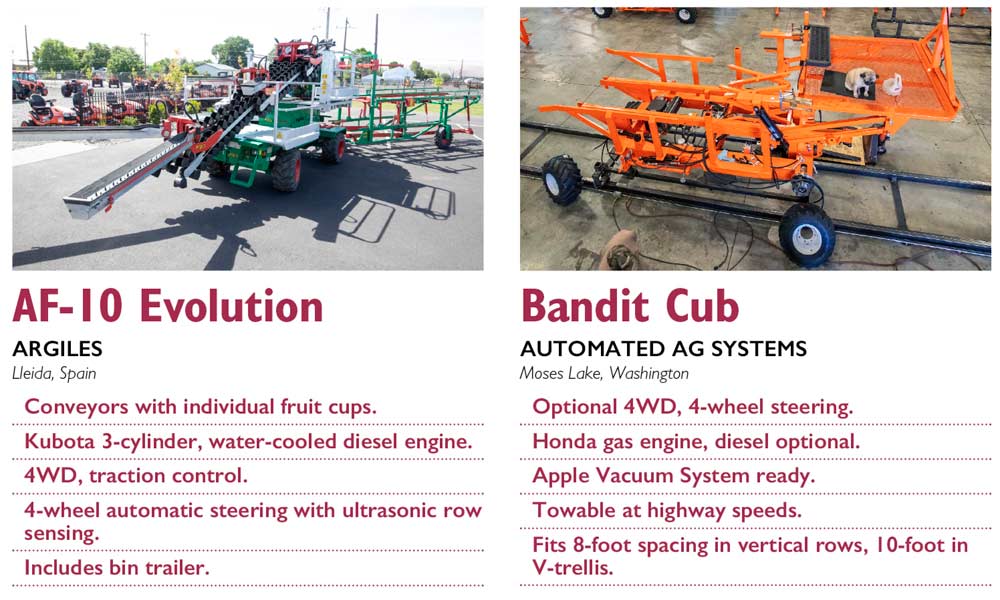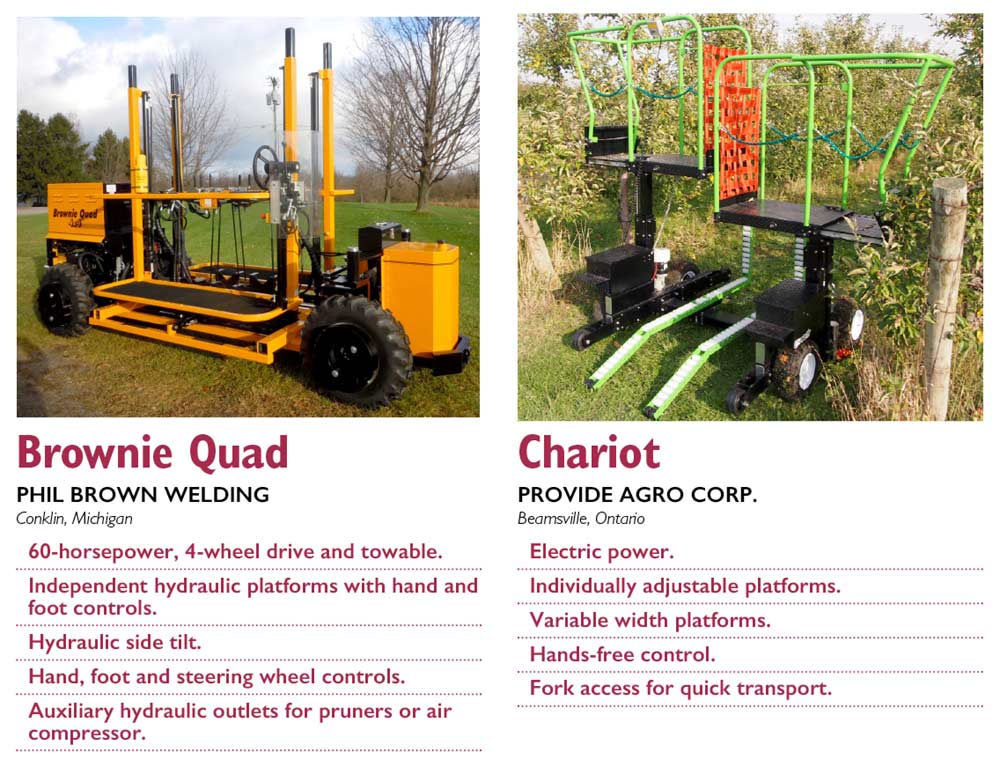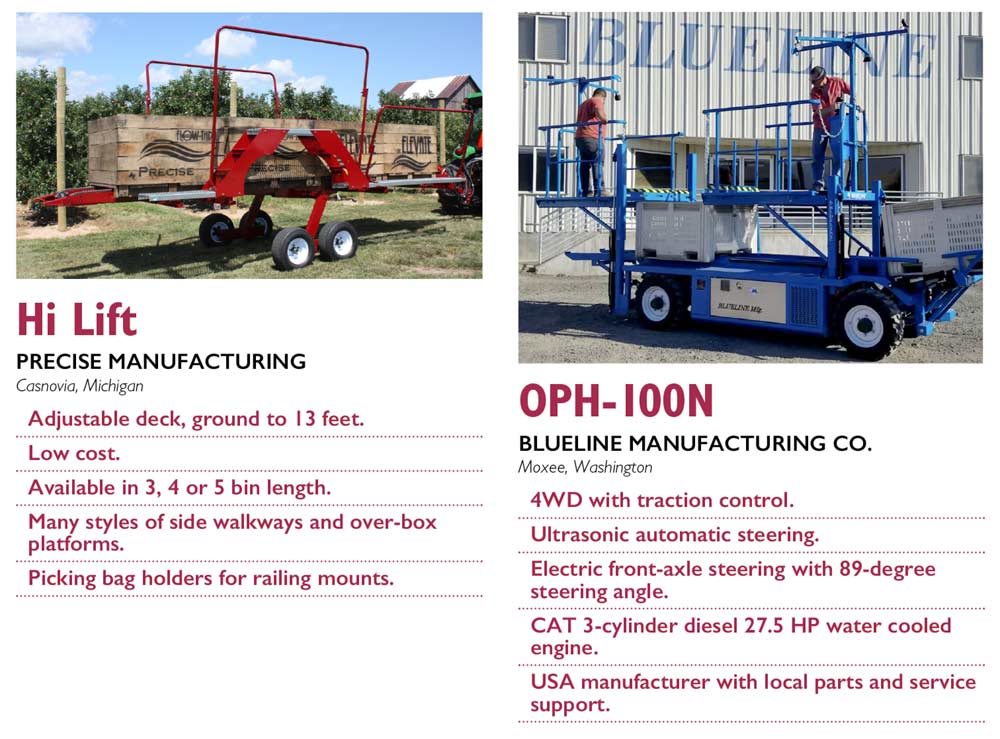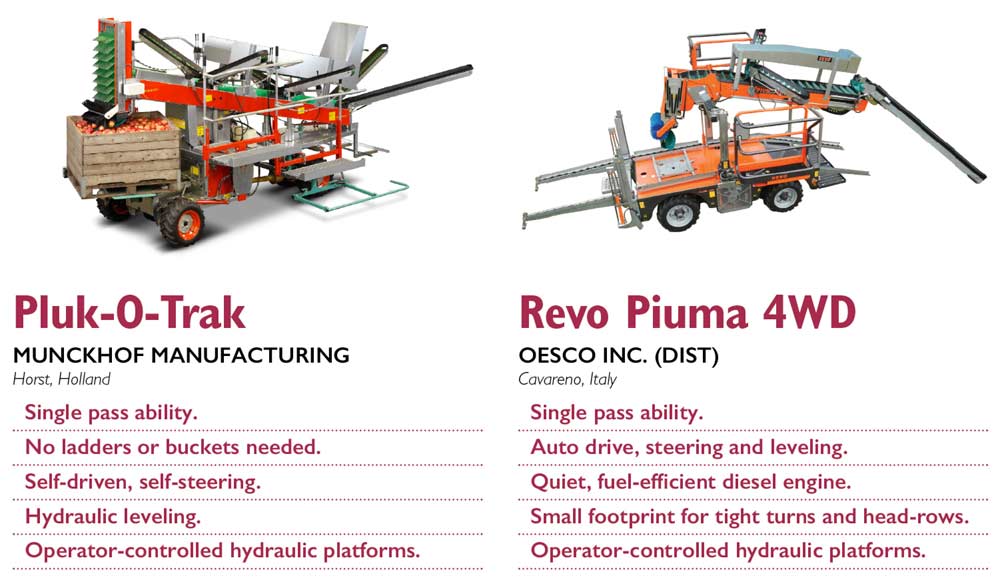Presented here, in alphabetical order, are 11 harvest platforms available to U.S. growers, with highlighted features for each, chosen by the vendors. It’s not an exhaustive list, but represents the latest or most widely available model from each manufacturer.
Robotic picking is not the only arena in the mechanization arms race.
Growers have a dizzying array of choices in harvest platforms, and unlike robots, they’re available today.
“It’s here now,” said Gregg Marrs, owner of Blueline Manufacturing Co. in Yakima, Washington.
Harvest platforms certainly aren’t new, but the technology is rapidly evolving and diversifying. Vendors have released several new models in the past few years. Blueline, for example, has distributed European imports for 20 years or so, but this year released its own model, the OPH-9000, and now has a smaller version, the OPH-100N, designed to operate in even tighter rows.

Then there is Automated Ag Systems of Moses Lake, Washington, one of the leaders in the platform race. The company has about 600 harvest platforms in orchards throughout the country now, most of them the Bandit Xpress, but Automated Ag also has a new, smaller version, called the Cub.
“In the world of platforms, the concept has been around awhile, but it all comes down to the recipe,” said JJ Dagorret, president and founder of Automated Ag.
Simplicity vs. features
Generally, manufacturers aim to find a balance between whiz-bang new features and ease of use.
Some machines have the ability to level the platform surface even if the wheels are on a side slope. Others have a sonar sensor to self-center in the row. Still others feature vacuum tubes or conveyor belts to carry an apple from a worker’s bucket gently to the bin.
However, all those features require moving parts or electronics that could mean specialized training to operate and fix, not to mention more money. Not all growers want that, preferring machines that entry-level workers can operate while picking.
“I can do anything with these machines,” Dagorret said. “If you want to fly, if you want to get airborne, I can do it. It’s just a matter of how much money.”

Dagorret has, instead, opted for simplicity in his machines. Parts are interchangeable. Electronics are few. Engines are gasoline-powered. He has eschewed self-leveling platforms as too complex. He boasts that most problems with his machines can be diagnosed over the phone.
Likewise, Huron Fruit Systems continues to upgrade its harvest platform, based on a stair-step concept, with increased ground clearance, onboard speed monitoring and an adjustable rear step to double the number of people working at one of the lower levels. Again, citing maintenance concerns, Huron has not added a leveling function.
“The more you put on a machine, the more complex it gets,” said Walter Wafler, owner of Huron Fruit Systems in Wolcott, New York.
Cost
Prices depend on features, of course, so picking platforms can range widely, from $15,000 to nearly $140,000 at the extremes; most fall in the $60,000 to $80,000 range.
True, that’s a lot of money for growers to shell out at one time, but they need to look beyond that, said Andy Dulude, sales representative for Oesco Inc., a distributor in Conway, Massachusetts, that sells two European picking platform models. By comparison, look how much modern, high-density orchards cost, he said.

“If they’re going to spend $30,000 to put in an acre of apples, they’re going to need to maintain that,” Dulude said.
The platforms get workers off ladders, saving time and preventing injuries, and involve less handling of fruit overall, meaning fewer bruises, he said.
At the low end in the American market is the Hi Lift, a bin trailer retrofitted with platforms and hydraulics that can reach up to 14 feet. The model was released four years ago by Precise Manufacturing in Casnovia, Michigan. The company charges $15,000 for it; for an extra $500, they will install a platform leveler for hills.
The company offers a true harvest platform for $65,000, called the Flow Thru, but the Hi Lift sells much better, said owner Mario VanDyke. It’s simpler, cheaper and can be used for a variety of applications. Growers often buy more than one. “That’s what farmers seem to be after,” VanDyke said.
One of the most expensive — and complex — picking platforms is the Apple Vacuum System from DBR Conveyor Concepts in Conklin, Michigan, just 12 miles away from Casnovia.

Mounted onto a Brownie Quad work platform, made by one of the partners in DBR, the vacuum system consists of tubes connected to buckets carried by workers. As soon as the picker puts an apple into the bucket, the vacuum pulls it through a tube, decelerates it and gently lays it into a bin with an electronic eye that drops the bin when it’s full and loads a new one from a trailer bin towed behind. The whole mechanism costs $138,500.
Mechanization in Michigan’s apple country saw a brief spike in interest four or five years ago, prompting the developments by Precise and DBR. However, since then, growers have bolstered their rates of H-2A hires, dampening sales just as the models rolled off the shelves for commercial availability, said VanDyke and Phil Brown, one of the owners of DBR.
“We were just starting to gain a little traction and then H-2A came in the area,” VanDyke said.
It was simply a matter of growers choosing to put their money more in people than equipment, Brown said, and the change affected the vacuum harvester more than the platforms.

This year, Brown and DBR have been working with Dagorret in Moses Lake to combine the vacuum system with the Bandit Xpress, one of the top selling platforms in the West. (See “Prototype picker” on Page 56.) The idea is that growers would be able to add the vacuum to equipment they already own.
“He (Dagorret) has got a lot of the Western market, which we haven’t been able to penetrate that well,” Brown said.
Platforms vs. robots
Few vendors seemed concerned that robotic pickers under development by companies such as Abundant Robotics and FF Robotics will replace the need for harvest platforms. For one thing, getting the apple off the tree is only half of the battle. Growers still need to get it into bins and out to the warehouse, as well as trim and train orchards at various heights.
Wafler of Huron Fruit Systems suspects the robotic technology won’t be ready for commercial orchardists for another 10 years or so, while platform technology can make a difference now. Trials show platforms can boost efficiency by, at the very least, 30 percent. At $60,000, growers could recover their investment in a relatively short time, while the costs for robotics remains unknown.

Meanwhile, orchardists may not be ready for robotic technology. Any complex machinery requires more skill to repair. “I’m a pretty smart guy and I sure … wouldn’t want to fix one of those,” Wafler said.
Still, the platform makers eye the automated harvest developments with excitement, viewing them as a fancier extension of their own work in the mechanization movement.
“It’s fun to be part of it,” VanDyke said. “It’s just fun to solve problems.” •
-by Ross Courtney
-Photo illustrations by Jared Johnson/Good Fruit Grower
Related story: Prototype picker: apple vacuum system tested






Leave A Comment